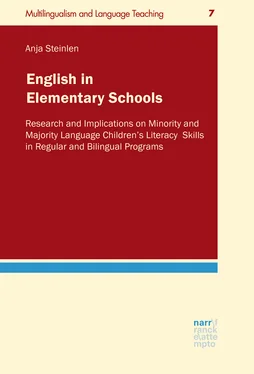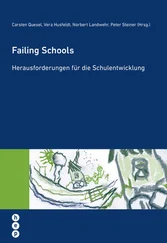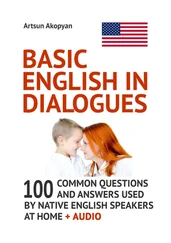In her review of IM programs, Wesche (2002) posited the question as to how much FL exposure would be needed to ensure adequate language development for learners in order to be able to maintain grade level learning in their other academic studies. She showed that in 50/50 IM programs with an early start (i.e., in grade 1 or kindergarten), a second language can be effectively taught, but that gains vis-a-vis early ‘total’ IM are lower, or roughly commensurate with the relative total time spent in the FL (Wesche, 2002). However, due to the restrictions outlined above, any comparisons involving total IM programs are not possible in Germany. As Wesche (2002) also pointed out, late-starting, low-intensity bilingual programs (i.e., 20/80 programs3 starting in grade 7) may be quite successful in enhancing the FL proficiency of academically-inclined (Gymnasium) students (for Germany see e.g., Burmeister & Daniel, 2002; Köller, Leucht & Pant, 2012; Nold, Hartig, Hinz & Rossa, 2008; Rumlich, 2016; Wode, 1995, 2009). Such programs may also be successful at the lower secondary school level, as shown in studies on Realschule (Rischawy, 2016) and Hauptschule (Schwab, 2013) in Germany. Thus, bilingual programs can be implemented at every school level without compromising age-appropriate subject knowledge. Evidence for 20/80 programs with an early start is, unfortunately, scarce (see also Piske, 2020). Here, the FL is generally offered in only one subject, often science for the elementary school context. The findings of pilot studies indicate improvement in FL learning from grade 1 to 4, although the scores of the language tests did not always differ in a statistically significant way from year to year (e.g., Couve de Murville, Kersten, Maier, Ponto & Weitz, 2016; Steinlen & Gerdes, 2015). Unfortunately, academic achievement was not taken into consideration in these studies.
In the following, “bilingual schools”, “bilingual programs” or “CLIL programs” are used as umbrella terms, which subsume bilingual programs with lower or higher intensity. The term “IM” (immersion) is ascribed to partial immersion programs where the FL is used more than 50% of the teaching time. Abbreviations such as Bili-20, Bili-50 or Bili-70 are used to illustrate the intensity of any bilingual program, in which 20%, 50% and 70%, respectively, are offered in the target language, with Bili-50 and Bili-70 programs corresponding to partial IM programs.
2.3.4 Bilingual programs as “elitist” programs
In Germany, bilingual programs are considered to be ‘elitist’ because they often are attended by students with particular personal, intellectual, or familial characteristics. This is partly due to the fact that schools do not always randomly assign students to a particular program, especially when there are more applicants than places (see e.g., Apsel, 2010; Genesee, 1987; Swain & Lapkin, 1982; Zaunbauer & Möller, 2007). Student-selection factors may include the age-appropriate knowledge of the L1, the ability to concentrate, perseverance, commitment and/or communication abilities (e.g., Kersten, Fischer, Burmeister, Lommel, Schelletter, Steinlen & Thomas, 2010b). For example, employing a large longitudinal study comparing students in mainstream and IM elementary schools in Germany, Zaunbauer & Möller (2007, see also Zaunbauer & Möller, 2006, 2010; Gebauer, Zaunbauer & Möller, 2012, 2013) reported that in grade 1, IM students outperformed their peers in mainstream programs in a nonverbal intelligence test and pointed out that these cognitive differences may also point to prior selection effects (see also chapter 2.6).
Elementary schools may discourage parents of struggling learners (e.g., dyslexic children and children with auditory / perceptual / concentration problems) to attend an IM program, often reasoning that such a program would be too large of a burden for such children (Fischer, 2019). Other schools have opted for an alternative solution: when more students than can be accepted to the bilingual program have applied for admission, these students are randomly assigned to a bilingual or regular school program. For example, many IM schools, particularly in Canada, employ a lottery system, as in the case of the St. Lambert school (e.g., Genesee, 1987). Ideally, then, the IM students would be identical to regular students in all respects, except that they would be enrolled in different programs. Indeed, the results of nonverbal intelligence tests carried out in the St. Lambert school did not show any differences between first graders in the IM and in the regular program (e.g., Lambert & MacNamara, 1969; Lambert & Tucker, 1972; Genesee, 1987).
The three schools where data have been drawn for this study deal very differently with the admission of students in their bilingual programs (see chapter 4.1 for more information). The Muhlius Schule in Kiel and the Platanus Schule in Berlin offer only one FL program, and that is a bilingual one. However, the Muhlius Schule is a public school, catering to a relatively high number of students with learning difficulties or associated problems that hinder learning (e.g., Steinlen & Gerdes, 2015), and there are no restrictions on admission. The Platanus Schule in Berlin is a private school, and the children are preselected for cognitive, linguistic and communicative skills (see Steinlen & Piske, 2018c). The Hügelschule in Tübingen, finally, has offered both a regular program and a partial immersion program since 2008/09 (e.g., Steinlen, 2016, 2017, 2018a, b; Steinlen & Piske, 2013, 2015, 2016a, b, 2018, 2020; Tamm, 2010). So far, a lottery system had to be employed only once. However, as teachers and the heads of the school point out, preselectional effects cannot be ruled out because the parents usually enroll their child in the bilingual program when they are very confident that s/he would indeed be able to master it without any difficulties (see also Apsel, 2012; Zydatiß, 2009: 161 for similar impressions). Despite this, the results of a nonverbal intelligence test conducted in grade 1 in this school, with 256 students attending either a regular or a bilingual program, did not indicate any significant differences between the two groups (Yadollahi, Steinlen & Piske, 2020, see also Steinlen & Piske i. pr.).
2.3.5 Curricula for bilingual teaching in Germany
In 2013, the Standing Conference of the Ministers of Education and Cultural Affairs (KMK, 2013b) published a report on bilingual instruction in Germany in secondary (but not in elementary) schools. In this context, bilingual instruction is defined similarly to CLIL (Eurydice, 2006), namely that “it refers to the teaching of a current subject other than foreign languages in more than one language” (KMK, 2013b: 3). The report emphasizes that the curriculum of the content subject constitutes the basis for bilingual instruction (KMK, 2013b: 8) and that the learning goal is content knowledge in the content subject in two languages. Furthermore, acquired knowledge and skills in the bilingual content subject should be the same as in the corresponding regular (i.e., monolingual German) content subject (KMK, 2013b: 8).
As the only Federal State to do so, the Ministerium Baden-Württemberg für Kultus, Jugend und Sport (2008) published information on bilingual instruction at the elementary school level (“Niveaukonkretisierungen”, supplementing the curriculum for English 2004-2015). Referring explicitly to the subject MeNuK (Fächerverbund Mensch, Natur und Kultur, which combines science and culture) as an appropriate bilingual content subject, English competences for grade 4 are very briefly described in terms of lexical knowledge, world knowledge and writing skills. Unfortunately, these expectations do not deviate much from the standards set for English-as-a-subject lessons (see Ministerium Baden-Württemberg für Kultus, Jugend und Sport, 2004); that is, the close link between FL and content learning has not been taken into consideration. Administrative regulations, approval requirements, scope and duration or teacher qualifications, assessment and certification measures are also not provided by the Ministries of Education for Baden-Württemberg, Berlin or Schleswig-Holstein.
Читать дальше












